The Blake Co.
Awnings & Flags
Flags Frequently Asked Questions
The following flag information is considered general knowledge and may be used freely without permission from the Blake Co.
Freedom to Display the American Flag Act of 2005
On Monday, July 24, 2006, President Bush signed into law H.R. 42, the "Freedom to Display the American Flag Act of 2005".
This law prohibits restrictions on displaying the American flag on certain residential property. The bill prevents a condominium association, cooperative association, or residential real estate management association from denying an owner or resident from displaying the American flag on their residential property within the association. This bill was sponsored by U.S. Rep. Roscoe Bartlett, R- Md.
1. How to Display the Flag.
2. How to Fold the America Flag and What it Means.
3. American Flag Evolution.
4. Determining Flag Size.
5. Caring For Your Flag.
6. How Long Will A Flag Last?
7. Flag Holidays.
8. When To Fly Old Glory At Half-Staff.
9. Flag Etiquette.
10. United States Code.
.
1. How to Display the Flag
TAP or CLICK HERE to download the following information "How to Display the Flag" as a PDF file.
 1. When the flag of the United States of America is displayed over the middle of the street, it
should be suspended vertically with the union to the north in an east and west street or to the
east in a north and south street.
1. When the flag of the United States of America is displayed over the middle of the street, it
should be suspended vertically with the union to the north in an east and west street or to the
east in a north and south street.
|
 2. The flag of the United States of America, when it is displayed with another flag against a wall
from crossed staffs, should be on the right, the flag's own right (that means the viewer's left),
and its staff should be in front of the staff of the other flag.
2. The flag of the United States of America, when it is displayed with another flag against a wall
from crossed staffs, should be on the right, the flag's own right (that means the viewer's left),
and its staff should be in front of the staff of the other flag.
|
 3. The flag of the United States of America, when flown at half-staff, should be first hoisted to
the peak for an instant and then lowered to the half-staff position. The flag should be again
raised to the peak before it is lowered for the day. By "half-staff" is meant
lowering the flag to one-half the distance between the top and bottom of the staff. Crepe
streamers may be affixed to spear heads or flagstaffs in a parade only by order of the President
of the United States. If other flags are displayed along with the flag of the United States,
all flags should be displayed at half-staff.
3. The flag of the United States of America, when flown at half-staff, should be first hoisted to
the peak for an instant and then lowered to the half-staff position. The flag should be again
raised to the peak before it is lowered for the day. By "half-staff" is meant
lowering the flag to one-half the distance between the top and bottom of the staff. Crepe
streamers may be affixed to spear heads or flagstaffs in a parade only by order of the President
of the United States. If other flags are displayed along with the flag of the United States,
all flags should be displayed at half-staff.
|
 4. When flags of States, cities, or localities, or pennants of societies are flown on the same halyard
with the flag of the United States of America, the latter should always be at the peak. When
the flags are flown from adjacent staffs, the flag of the United States of America should be hoisted
first and lowered last. No such flag or pennant may be placed above the flag of the United
States of America or to the right of the flag of the United States of America (that means the
viewer’s left).
4. When flags of States, cities, or localities, or pennants of societies are flown on the same halyard
with the flag of the United States of America, the latter should always be at the peak. When
the flags are flown from adjacent staffs, the flag of the United States of America should be hoisted
first and lowered last. No such flag or pennant may be placed above the flag of the United
States of America or to the right of the flag of the United States of America (that means the
viewer’s left).
|
 5. When flags of two or more nations are displayed, they are to be flown from separate staffs of the
same height. The flags should be of approximately equal size. International usage forbids
the display of the flag of one nation above that of another nation in time of peace. In the
United States, the flag of the United States of America takes the position of honor which is to the
viewer’s left. The remaining nation’s flags are then displayed in alphabetical order.
5. When flags of two or more nations are displayed, they are to be flown from separate staffs of the
same height. The flags should be of approximately equal size. International usage forbids
the display of the flag of one nation above that of another nation in time of peace. In the
United States, the flag of the United States of America takes the position of honor which is to the
viewer’s left. The remaining nation’s flags are then displayed in alphabetical order.
|
 6. When the flag of the United States of America is suspended over a sidewalk from a rope extending
from a house to a pole at the edge of the sidewalk, the flag should be hoisted out, union first, from
the building.
6. When the flag of the United States of America is suspended over a sidewalk from a rope extending
from a house to a pole at the edge of the sidewalk, the flag should be hoisted out, union first, from
the building.
|
 7. When the flag of the United States of America is displayed from a staff projecting horizontally
or at an angle from the window sill, balcony, or front of a building, the union of the flag should
be placed at the peak of the staff unless the flag is at half-staff.
7. When the flag of the United States of America is displayed from a staff projecting horizontally
or at an angle from the window sill, balcony, or front of a building, the union of the flag should
be placed at the peak of the staff unless the flag is at half-staff.
|
 8. When the flag of the United States of America is used to cover a casket, it should be so placed
that the union is at the head and over the left shoulder. The flag should not be lowered into the
grave or allowed to touch the ground.
8. When the flag of the United States of America is used to cover a casket, it should be so placed
that the union is at the head and over the left shoulder. The flag should not be lowered into the
grave or allowed to touch the ground.
|
 9. When the flag of the United States of America is displayed in a manner other than by being flown
from a staff, it should be displayed flat, whether indoors or out. When displayed either
horizontally or vertically against a wall, the union should be uppermost and to the flag's own right
(that means to the viewer's left). When displayed in a window it should be displayed in the
same way, which is with the union or blue field to the left of the observer in the street. When
festoons, rosettes or draping are desired, bunting of blue, white and red should be used, but never
the flag.
9. When the flag of the United States of America is displayed in a manner other than by being flown
from a staff, it should be displayed flat, whether indoors or out. When displayed either
horizontally or vertically against a wall, the union should be uppermost and to the flag's own right
(that means to the viewer's left). When displayed in a window it should be displayed in the
same way, which is with the union or blue field to the left of the observer in the street. When
festoons, rosettes or draping are desired, bunting of blue, white and red should be used, but never
the flag.
|
 10. When the flag of the United States of America is carried in a procession with another flag, or
flags, the flag of the United States of America should be either on the marching right; that is, the
flag's own right, or, if there is a line of other flags, in front of the center of that line.
10. When the flag of the United States of America is carried in a procession with another flag, or
flags, the flag of the United States of America should be either on the marching right; that is, the
flag's own right, or, if there is a line of other flags, in front of the center of that line.
|
 11. The flag of the United States of America should be at the center and at the highest point of the
group when a number of flags of States or localities or pennants of societies are grouped and
displayed from staffs.
11. The flag of the United States of America should be at the center and at the highest point of the
group when a number of flags of States or localities or pennants of societies are grouped and
displayed from staffs.
|
 12. When the flag of the United States of America is on a platform, as if facing the audience, it
should be on its right (the audience's left).
12. When the flag of the United States of America is on a platform, as if facing the audience, it
should be on its right (the audience's left).
|
 13. When the flag of the United States of America is off a platform, as part of the audience, it
should be on its right (the audience's right).
13. When the flag of the United States of America is off a platform, as part of the audience, it
should be on its right (the audience's right).
|
.
2. How to Fold the America Flag and What it Means
TAP or CLICK HERE to download this information on how to fold the American flag and what it means as a PDF file.
As an Army and Navy custom, the flag is lowered daily at the last note of retreat. Special care should be taken that no part of the flag touches the ground.
The Flag is then carefully folded into the shape of a tri-cornered hat, emblematic of the hats worn by colonial soldiers during the war for Independence.
In the folding, the red and white stripes are finally wrapped into the blue, as the light of day vanishes into the darkness of night.
This custom of special folding is reserved for the American Flag alone.
 To properly fold the Flag, begin by holding it waist-high with another person so that its surface is parallel to the ground.
To properly fold the Flag, begin by holding it waist-high with another person so that its surface is parallel to the ground.
|
 The 1st fold of the flag is a symbol of life.
The 1st fold of the flag is a symbol of life.
|
 The 2nd fold is a symbol of the belief in eternal life.
The 2nd fold is a symbol of the belief in eternal life.
|
 The 3rd fold is made in honor and remembrance of the veterans departing the ranks who gave a portion of their lives for the defense of the country to attain peace throughout the world.
The 3rd fold is made in honor and remembrance of the veterans departing the ranks who gave a portion of their lives for the defense of the country to attain peace throughout the world.
|
 The 4th fold represents the weaker nature, for as American citizens trusting in God, it is to Him we turn in times of peace as well as in time of war for His divine guidance.
The 4th fold represents the weaker nature, for as American citizens trusting in God, it is to Him we turn in times of peace as well as in time of war for His divine guidance.
|
 The 5th fold is a tribute to the country, for in the words of Stephen Decatur, "Our Country, in dealing with other countries, may she always be right; but it is still our country, right or wrong.
The 5th fold is a tribute to the country, for in the words of Stephen Decatur, "Our Country, in dealing with other countries, may she always be right; but it is still our country, right or wrong.
|
 The 6th fold is for where people's hearts lie. It is with their heart that they pledge allegiance to the flag of the United States of America, and to the republic for which it stands, one nation under God, indivisible, with liberty and justice for all.
The 6th fold is for where people's hearts lie. It is with their heart that they pledge allegiance to the flag of the United States of America, and to the republic for which it stands, one nation under God, indivisible, with liberty and justice for all.
|
 The 7th fold is a tribute to its Armed Forces, for it is through the Armed Forces that they protect their country and their flag against all her enemies, whether they be found within or without the boundaries of their republic.
The 7th fold is a tribute to its Armed Forces, for it is through the Armed Forces that they protect their country and their flag against all her enemies, whether they be found within or without the boundaries of their republic.
|
 The 8th fold is a tribute to the one who entered into the valley of the shadow of death, that we might see the light of day.
The 8th fold is a tribute to the one who entered into the valley of the shadow of death, that we might see the light of day.
|
 The 9th fold is a tribute to womanhood, and Mothers. For it has been through their faith, their love, loyalty and devotion that the character of the men and women who have made this country great has been molded.
The 9th fold is a tribute to womanhood, and Mothers. For it has been through their faith, their love, loyalty and devotion that the character of the men and women who have made this country great has been molded.
|
 The 10th fold is a tribute to the father, for he, too, has given his sons and daughters for the defense of their country since they were first born.
The 10th fold is a tribute to the father, for he, too, has given his sons and daughters for the defense of their country since they were first born.
|
 The 11th fold represents the lower portion of the seal of King David and King Solomon and glorifies in the Hebrews eyes, the God of Abraham, Isaac and Jacob.
The 11th fold represents the lower portion of the seal of King David and King Solomon and glorifies in the Hebrews eyes, the God of Abraham, Isaac and Jacob.
|
 The 12th fold represents an emblem of eternity and glorifies, in the Christians eyes, God the Father, the Son and Holy Spirit. |
 The 13th fold, or when the flag is completely folded, the stars are uppermost reminding them of their nation’s motto, "In God We Trust. |
After the flag is completely folded and tucked in, it takes on the appearance of a cocked hat, ever reminding us of the soldiers who served under General George Washington, and the Sailors and Marines who served under Captain John Paul Jones, who were followed by their comrades and shipmates in the Armed Forces of the United States, preserving for them the rights, privileges and freedoms they enjoy today.
.
3. American Flag Evolution
Many people believe that the first official American flag was the "Betsy Ross" flag which had 13 stars in a circle. But the first documented American flag was the 13 star staggered pattern shown below.
By law, a star is added to the American flag on the Fourth of July following the admission of the state(s) to the Union.
| 13 Stars 1777 - 1795 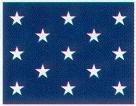 Connecticut, Delaware, Georgia, Maryland, New Hampshire, New Jersey, North Carolina, Pennsylvania, Rhode Island, South Carolina, Virginia
Connecticut, Delaware, Georgia, Maryland, New Hampshire, New Jersey, North Carolina, Pennsylvania, Rhode Island, South Carolina, Virginia
|
15 Stars 1795 - 1818 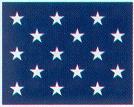 Kentucky, Vermont
Kentucky, Vermont
|
20 Stars 1818 - 1819 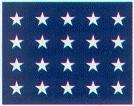 Indiana, Louisiana, Mississippi, Ohio, Tennessee
Indiana, Louisiana, Mississippi, Ohio, Tennessee
|
| 21 Stars 1819 - 1820 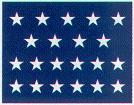 Illinois
Illinois
|
23 Stars 1820 - 1822 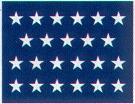 Alabama, Maine
Alabama, Maine
|
24 Stars 1822 - 1836 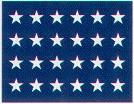 Missouri
Missouri
|
| 25 Stars 1836 - 1837 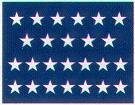 Arkansas
Arkansas
|
26 Stars 1837 - 1845 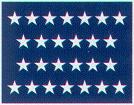 Michigan
Michigan
|
27 Stars 1845 - 1846 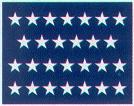 Florida
Florida
|
| 28 Stars 1846 - 1847 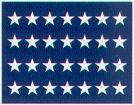 Texas
Texas
|
29 Stars 1847 - 1848 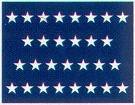 Iowa
Iowa
|
30 Stars 1848 - 1851 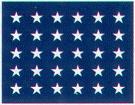 Wisconsin
Wisconsin
|
| 31 Stars 1851 - 1858 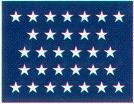 California
California
|
32 Stars 1858 - 1859 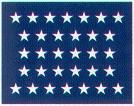 Minnesota
Minnesota
|
33 Stars 1859 - 1860 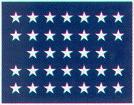 Oregon
Oregon
|
| 34 Stars 1861 - 1863 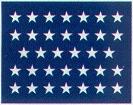 Kansas
Kansas
|
35 Stars 1863 - 1865 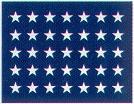 West Virginia
West Virginia
|
36 Stars 1865 - 1867 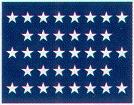 Nevada
Nevada
|
| 37 Stars 1867 - 1877 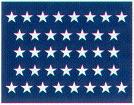 Nebraska
Nebraska
|
38 Stars 1877 - 1890 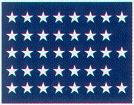 Colorado
Colorado
|
43 Stars 1890 - 1891 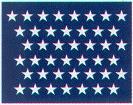 Idaho, Montana, North Dakota, South Dakota, Washington
Idaho, Montana, North Dakota, South Dakota, Washington
|
| 44 Stars 1891 - 1896 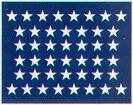 Wyoming
Wyoming
|
45 Stars 1896 - 1908 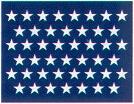 Utah
Utah
|
46 Stars 1908 - 1912 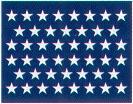 Oklahoma
Oklahoma
|
| 48 Stars 1912 - 1959 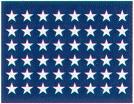 Arizona, New Mexico
Arizona, New Mexico
|
49 Stars 1959 -1960 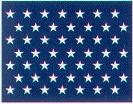 Alaska
Alaska
|
50 Stars 1960 to Present 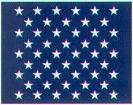 Hawaii
Hawaii
|
.
4. Determining Flag Size
This guide applies primarily to inground flagpoles 20' and taller.
The size of the flagpole is what usually determines the correct size flag you should fly. Flag manufacturers recommend that the length of the flag should be at least one-forth the height of the flagpole.
Examples: A 20' flagpole should have at least a 3x5' flag (20' flagpole divided by 4 equals 5 or a 3x5' flag). A 40' flagpole should have at least a 6x10' flag (40' flagpole divided by 4 equals 10 or a 6x10' flag).
Most residential flags are 3x5' or 4x6'. Most small commercials buildings will use a 5x8' or 6x10' flag. Larger buildings may require an 8x12' flag or larger.
You may always fly a larger flag than what is recommended. However, be aware that "over flagging" a flagpole may damage the flagpole or break the halyard (rope) during high winds. If you wish to fly an extra large flag we recommend that you fly a Nylon flag since it weighs less than a Polyester flag, especially when wet. But flying a Nylon flag is still no guarantee that your flagpole will not be damaged during high winds.
.
5. Caring For Your Flag
It has been well documented that given reasonable care your flag should provide maximum service and satisfaction. However, regardless of how well a flag is constructed, a flag is, after all, only a piece of cloth and will sooner or later succumb to the elements. And only you can prevent premature flag wear.
Here are a few simple suggestions that will help contribute greatly to the life of your flag:
1. Only flags made specifically for outdoor use should be displayed outdoors.
2. Avoid flying your flag in rain, snow and especially abnormally high winds. These weather extremes will shorten the life of your flag. Do not fold or roll-up a wet flag. Allow your flag to dry completely before storage.
3. Clean your flag regularly. This will keep your flag’s colors looking good. Clean your flag before dirt, smoke, dust and other airborne contaminates "set" into the fabric. Outdoor flags may be hand-washed in warm water and a mild soap, then rinse thoroughly and lay flat to dry. Do not allow the flag to soak in the wash water for an extended time or the colors may run. Professional dry cleaning is recommended for indoor and parade flags. Outdoor flags can be dry cleaned, too. You may find that many dry cleaners will clean Old Glory free of charge.
4. Do not fly the flag where the wind will rub it against any rough surfaces like trees, wires, walls or roofs. The smallest tear will only get worse with time. Keep your flagpole surfaces clean and free of rust or corrosion that could damage your flag.
5. Inspect your flag regularly for any signs of dirt or wear. Usually the first place that wears is the "fly end". This is the end farthest away from the staff or flagpole. When the fly end starts to ware it can be trimmed off and re-hemmed. This will help to extend the useful life of your flag. Re-hem your flag as soon as possible. The longer you wait the more the flag is shorted. The flag can only be re-hem a reasonable number of time and will eventually be too short to re-hem. The flag should then be ceremoniously retired. Many dry cleaners, tailors, upholstery shops and flag dealers will re-hem your flag for a minimal fee or even at no charge. Some flag dealers and most Boy Scouts will gladly retire your flag at no charge.
Note to large flag users (5x8’ and larger):
Larger flags naturally represent a more significant investment. Therefore it pays to take care
of your flag and give it maximum protection. Pay special attention to inspecting your flag
regularly and keeping your flag repaired. A good idea is to have 2 flags so you can rotate
them on a regular basis like every month. Test have shown that flag fibers actually benefit
from a periodic "rest". And by having 2 flags you can have one flag on display while
the other flag is out for cleaning or repair.
.
6. How Long Will A Flag Last
This is a copy of the flag care insert that a major flag manufacturer includes with their larger flags:
"One of the most often asked questions about flags is 'How long will an outdoor flag last'?
To help you understand this question, please consider the following facts. Weather, airborne contaminations and treatment of a flag, all play a major role in preservations or demise. Major enemies of all flags are wind, water, and sun; however, the single greatest cause of flag deterioration is CARELESSNESS. We cannot control the weather, but we can take care of the flag and the length of its life. When a snow, ice, sleet, freeing rain or high wind storm approaches, it is essential to take the flag down BEFORE the storm. Do not raise the flag until the storm has passed. Premature wear and tear of your flag could happen if the flag is left up during the storm including ripping and tearing.
Our flag are manufactured to give maximum service in return for reasonable care and sensible use. No two flags receive identical wear. Weather conditions vary and so does the life of each flag.
The best way we know how to stretch your flag dollar is to follow the above advice. You can also occasionally wash the flag in warm mild-detergent water, and let the flag air dry thoroughly before storing. Always have a flag repaired at the first sign of fraying and have back-up flags, rotating them often."
My personal experiences have found that when properly displayed and maintained you can expect the average size 3x5' good quality outdoor flag to last 6 months to a year. But one extremely winding day can damage a brand new flag made from the best flag material.
Generally speaking, the larger the flag the sooner it will wear out and winter months are much harder on flags then summer months.
Nylon and polyester flags are best for outdoor use with polyester being better for high-wind areas. In my option cotton flags should only be used for parade use or for indoor use when they are displayed out of direct sunlight. Cotton flags tend to fade very quickly from sunlight, and in some cases will show signs fading in as little as 30 days.
If your flagpole is light-weight in design, such as a telescoping or sectional residential flagpole, I suggest a nylon flag since it is not as heavy as a polyester flag and less likely to damage your flagpole in high winds.
Remember, only you can extend the life of your flag by taking care of it and by trying not to display it during high-wind storms. When your flag shows the first sign of wear have it repaired as soon as possible. We will cut-off the torn fly end and re-sew a new hem for free. The flag will become shorter in length so the sooner you have it repaired the less the flag will be cut-off.
When your flag is ready for retirement PLEASE DO NOT PLACE IT IN THE TRASH. Most boy scouts and some VFW post will gladly accept your American flags for retirement. We also collect US flags for a proper retirement. The boy scouts pick them up from us regularly.
.
7. Flag Holidays
The U.S. flag may be displayed everyday and especially on these days.
- New Year’s Day, January 1
- Martin Luther King, Jr.’s Birthday, third Monday in January
- Inauguration Day, January 20
- Lincoln’s Birthday, February 12
- President’s Day, third Monday in February
- Easter Sunday, variable
- Mother’s Day, second Sunday in May
- Peace Officers Memorial Day, May 15
- Armed Forces Day (half-staff all day), third Saturday in May
- Memorial Day (half-staff until noon), last Monday in May
- Flag Day, June 14
- Independence Day, July 4
- Korean War Veterans Armistice Day (half-staff all day), July 27
- Labor Day, first Monday in September
- Patriot Day (half-staff all day), September 11
- Constitution Day, September 17
- Columbus Day, second Monday in October
- Navy Day, October 27
- Veterans Day, November 11
- Thanksgiving Day, fourth Thursday in November
- Pearl Harbor Day (half-staff all day), December 7
- Christmas Day, December 25
Other days may be proclaimed by the President of the United States as flag holidays.
.
8. When To Fly Old Glory At Half-Staff
Half-staff does not necessarily mean the flag needs to be displayed in the middle of the flagpole. The half-staff position is approximately the height of one flag down from the top of the flagpole. This is especially important on very tall flagpoles so the flag will not touch the ground or bushes.
Old Glory should be flown at half-staff all day on the following days:
- May 15: Peace Officers Memorial Day
- Third Saturday in May: Armed Forces Day
- July 27: Korean War Veterans Armistice Day
- September 11: Patriot Day
- December 7: Pearl Harbor Remembrance Day
Old Glory should be flown at half-staff until noon on the following day:
- Last Monday in May: Memorial Day
There may be certain times when a state or federal government will request that the American flag be flown at half-staff. However, you do not have to wait for or need a government declaration to fly the American flag at half-staff. It may be flown at half-staff out of respect for any person or persons of your choice.
Please read the section on Flag Etiquette or How to Display the Flag for information on how to fly the flag at half-staff.
.
9. Flag Etiquette
The National Flag represents the living country and is considered to be a living thing emblematic of the respect and pride we have for our nation. Our flag is a precious possession. Display it proudly but display it properly.
The National Emblem is a symbol of our great country, our heritage and our place in the world. We owe reverence and respect to our flag. It represents the highest ideals of individual liberty, justice and equal opportunity for all.
- The fundamental rule of flag etiquette is: Treat all flags with respect and common sense.
- The Stars and Stripes takes precedence over all other flags when flown within the United States. It should not be flown lower than any other flag nor should it be smaller than any other flag flown with it. Other flags may, however, be flown at the same height and at the same size.
- Other national flags should not be smaller nor flown lower than the Stars and Stripes when displayed together. When displaying two or more nation's flags together each flag should be on separate staffs of the same height. Each flag should be approximately the same size.
- International customs forbid displaying one nation's flag over another in times of peace. This is a sign of war time victory and can be seen as a serious insult. If it is not possible to display two or more national flags at the same height, it is not proper to display them together at all.
- The position of honor is on the extreme left from the standpoint of the observer. The order from left to right of flags flown together is: The Stars and Stripes, other national flags in alphabetical order, state flags, county and city flags, organizational flags, then personal flags. The only exception to this rule is at the United Nations Building where the flags are all displayed in alphabetical order.
- If one flag is at half-staff in mourning, other flags flown with it should be at half-staff. When raising the flags to half-staff at the beginning of the day first raise the flags to their peak, then lower to half-staff. When lowering the flags from half-staff at the end of the day first raise them to full-staff for a moment then lower them. The Stars and Stripes is raised first and lowered last.
- Regarding vehicles, the flag should not be draped over the hood, top, sides, or back of a vehicle, railroad train or boat. Then the flag is displayed on a motorcar, the staff shall be fixed firmly to the chassis or clamped to the right fender.
- When the flag is suspended across a corridor or lobby in a building with only one main entrance, it should be suspended vertically with the union on the flag to the observer's left upon entering. If the building has more than one main entrance, the flag should be suspended vertically near the center of the corridor or lobby with the union to the North when entrances are to the East or West, or to the East when entrances are to the North and South. If there are entrances in more than two directions, the union should be to the East.
- When the flag is used to cover a casket, it should be placed so the union is at the head and over the left shoulder (heart) of the deceased. The flag should not be lowered into the grave or allowed to touch the ground.
- The flag should never be used for advertising purposes in any manner whatsoever. It should not be embroidered or printed on such articles like cushions, handkerchiefs and the like, printed or impressed on paper napkins or boxes or anything that is designed for temporary use and discard. Advertising signs should not be fastened to a staff or halyard from which the flag is flown.
- A salute (hand over heart for those not in uniform) should be rendered when the flag is raised, lowered, or carried by on parade; when the Pledge of Allegiance is recited, and when the national anthem is played (unless the flag is not present).
- It is proper to fly the Stars and Stripes at night but only if properly illuminated.
- No flag should be flown during weather which might damage it, based on common sense interpretation of circumstances.
- To extend the life of a flag, when it is torn, it should be repaired and under no circumstances should a flag be folded while wet.
- When a flag is no longer of dignified appearance and cannot be repaired, it should be destroyed in a dignified way.
- In a public gathering (lecture hall, church, etc.), the Stars and Stripes should be to the right of the speakers or on the wall behind them.
- The canton of the flag (the blue field with the 50 stars) should always be to the observers' left except: 1) when displayed on a casket; 2) when displayed as a decal on the right side of a vehicle (bus, truck, plane, etc.); 3) when worn as a patch on the right arm (the left arm is preferable).
- The Stars and Stripes should be in the center of a group of flags only when: 1) The center pole is taller than the others or 2) When a fan-like arrangement makes the center pole higher than the others.
- It is not illegal or improper to fly any flag alone (state, ethnic group, organization, etc.), but it is always preferable to display the Stars and Stripes at the same time.
.
10. United States Code
Title 36 - Patriotic Societies and Observances
Chapter 10 - Patriotic Customs
01/24/94
¡± 173. Display and use of flag by civilians; codification of rules and customs; definition
¡± 174. Time and occasions for display
¡± 175. Position and manner of display
¡± 176. Respect for flag
¡± 177. Conduct during hoisting, lowering or passing of flag
¡± 178. Modification of rules and customs by President
¡± 173. Display and use of flag by civilians; codification of rules and customs; definition
The following codification of existing rules and customs pertaining to the display and use
of the flag of the United States of America is established for the use of such civilians or
civilian groups or organizations as may not be required to conform with regulations promulgated
by one or more executive departments of the Government of the United States. The flag of
the United States for the purpose of this chapter shall be defined according to sections 1 and 2
of title 4 and Executive Order 10834 issued pursuant thereto.
¡± 174. Time and occasions for display
(a) Display on buildings and stationary flagstaffs in open; night display It is the universal
custom to display the flag only from sunrise to sunset on buildings and on stationary flagstaffs
in the open. However, when a patriotic effect is desired, the flag may be displayed twenty-four
hours a day if properly illuminated during the hours of darkness.
(b) Manner of hoisting
The flag should be hoisted briskly and lowered ceremoniously.
(c) Inclement weather
The flag should not be displayed on days when the weather is inclement, except when an all weather
flag is displayed.
(d) Particular days of display
The flag should be displayed on all days, especially on New Year's Day, January 1; Inauguration
Day, January 20; Lincoln's Birthday, February 12; Washington's Birthday, third Monday in
February; Easter Sunday (variable); Mother's Day, second Sunday in May; Armed Forces Day, third
Saturday in May; Memorial Day (half-staff until noon), the last Monday in May; Flag Day, June 14;
Independence Day, July 4; Labor Day, first Monday in September; Constitution Day, September 17;
Columbus Day, second Monday in October; Navy Day, October 27; Veterans Day, November 11;
Thanksgiving Day, fourth Thursday in November; Christmas Day, December 25; and such other days
as may be proclaimed by the President of the United States; the birthdays of States (date of
admission); and on State holidays.
(e) Display on or near administration building of public institutions
The flag should be displayed daily on or near the main administration building of every public
institution.
(f) Display in or near polling places
The flag should be displayed in or near every polling place on election days.
(g) Display in or near schoolhouses
The flag should be displayed during school days in or near every schoolhouse.
¡± 175. Position and manner of display
The flag, when carried in a procession with another flag or flags, should be either on the marching
right; that is, the flag's own right, or, if there is a line of other flags, in front of the center
of that line.
(a) The flag should not be displayed on a float in a parade except from a staff, or as provided
in subsection (i) of this section.
(b) The flag should not be draped over the hood, top, sides, or back of a vehicle or of a railroad
train or a boat. When the flag is displayed on a motorcar, the staff shall be fixed firmly to the
chassis or clamped to the right fender.
(c) No other flag or pennant should be placed above or, if on the same level, to the right of the
flag of the United States of America, except during church services conducted by naval chaplains
at sea, when the church pennant may be flown above the flag during church services for the
personnel of the Navy. No person shall display the flag of the United Nations or any other
national or international flag equal, above, or in a position of superior prominence or honor to,
or in place of, the flag of the United States at any place within the United States or any
Territory or possession thereof: Provided, That nothing in this section shall make unlawful the
continuance of the practice heretofore followed of displaying the flag of the United Nations in a
position of superior prominence or honor, and other national flags in positions of equal prominence
or honor, with that of the flag of the United States at the headquarters of the United Nations.
(d) The flag of the United States of America, when it is displayed with another flag against a
wall from crossed staffs, should be on the right, the flag's own right, and its staff should be in
front of the staff of the other flag.
(e) The flag of the United States of America should be at the center and at the highest point
of the group when a number of flags of States or localities or pennants of societies are grouped
and displayed from staffs.
(f) When flags of States, cities, or localities, or pennants of societies are flown on the same
halyard with the flag of the United States, the latter should always be at the peak. When
the flags are flown from adjacent staffs, the flag of the United States should be hoisted first
and lowered last. No such flag or pennant may be placed above the flag of the United States or
to the United States flag's right.
(g) When flags of two or more nations are displayed, they are to be flown from separate staffs of
the same height. The flags should be of approximately equal size. International usage
forbids the display of the flag of one nation above that of another nation in time of peace.
(h) When the flag of the United States is displayed from a staff projecting horizontally or at
an angle from the window sill, balcony, or front of a building, the union of the flag should be
placed at the peak of the staff unless the flag is at half staff. When the flag is suspended
over a sidewalk from a rope extending from a house to a pole at the edge of the sidewalk, the
flag should be hoisted out, union first, from the building.
(i) When displayed either horizontally or vertically against a wall, the union should be uppermost
and to the flag's own right, that is, to the observer's left. When displayed in a window,
the flag should be displayed in the same way, with the union or blue field to the left of the
observer in the street.
(j) When the flag is displayed over the middle of the street, it should be suspended vertically
with the union to the north in an east and west street or to the east in a north and south street.
(k) When used on a speaker's platform, the flag, if displayed flat, should be displayed above and
behind the speaker. When displayed from a staff in a church or public auditorium, the flag
of the United States of America should hold the position of superior prominence, in advance of the
audience, and in the position of honor at the clergyman's or speaker's right as he faces the
audience. Any other flag so displayed should be placed on the left of the clergyman or speaker
or to the right of the audience.
(l) The flag should form a distinctive feature of the ceremony of unveiling a statue or monument,
but it should never be used as the covering for the statue or monument.
(m) The flag, when flown at half-staff, should be first hoisted to the peak for an instant and then
lowered to the half-staff position. The flag should be again raised to the peak before it is
lowered for the day. On Memorial Day the flag should be displayed at half-staff until noon
only, then raised to the top of the staff. By order of the President, the flag shall be flown
at half-staff upon the death of principal figures of the United States Government and the Governor
of a State, territory, or possession, as a mark of respect to their memory. In the event of
the death of other officials or foreign dignitaries, the flag is to be displayed at half-staff
according to Presidential instructions or orders, or in accordance with recognized customs or
practices not inconsistent with law. In the event of the death of a present or former official
of the government of any State, territory, or possession of the United States, the Governor of that
State, territory, or possession may proclaim that the National flag shall be flown at half-staff.
The flag shall be flown at half-staff thirty days from the death of the President or a former President;
ten days from the day of death of the Vice President, the Chief Justice or a retired Chief Justice
of the United States, or the Speaker of the House of Representatives; from the day of death until
interment of an Associate Justice of the Supreme Court, a Secretary of an executive or military
department, a former Vice President, or the Governor of a State, territory, or possession; and on
the day of death and the following day for a Member of Congress. As used in this subsection -
(1) the term "half-staff" means the position of the flag when it is one-half the distance
between the top and bottom of the staff;
(2) the term "executive or military department" means any agency listed under sections 101
and 102 of title 5; and
(3) the term "Member of Congress" means a Senator, a Representative, a Delegate, or the
Resident Commissioner from Puerto Rico.
(n) When the flag is used to cover a casket, it should be so placed that the union is at the head and
over the left shoulder. The flag should not be lowered into the grave or allowed to touch the
ground.
(o) When the flag is suspended across a corridor or lobby in a building with only one main entrance,
it should be suspended vertically with the union of the flag to the observer's left upon entering.
If the building has more than one main entrance, the flag should be suspended vertically near the
center of the corridor or lobby with the union to the north, when entrances are to the east and west
or to the east when entrances are to the north and south. If there are entrances in more than
two directions, the union should be to the east.
¡± 176. Respect for flag
No disrespect should be shown to the flag of the United States of America; the flag should not be
dipped to any person or thing. Regimental colors, State flags, and organization or
institutional flags are to be dipped as a mark of honor.
(a) The flag should never be displayed with the union down, except as a signal of dire distress in
instances of extreme danger to life or property.
(b) The flag should never touch anything beneath it, such as the ground, the floor, water, or
merchandise.
(c) The flag should never be carried flat or horizontally, but always aloft and free.
(d) The flag should never be used as wearing apparel, bedding, or drapery. It should never
be festooned, drawn back, nor up, in folds, but always allowed to fall free. Bunting of blue,
white, and red, always arranged with the blue above, the white in the middle, and the red below,
should be used for covering a speaker's desk, draping the front of the platform, and for decoration
in general.
(e) The flag should never be fastened, displayed, used, or stored in such a manner as to permit it
to be easily torn, soiled, or damaged in any way.
(f) The flag should never be used as a covering for a ceiling.
(g) The flag should never have placed upon it, nor on any part of it, nor attached to it any mark,
insignia, letter, word, figure, design, picture, or drawing of any nature.
(h) The flag should never be used as a receptacle for receiving, holding, carrying, or delivering
anything.
(i) The flag should never be used for advertising purposes in any manner whatsoever. It
should not be embroidered on such articles as cushions or handkerchiefs and the like, printed
or otherwise impressed on paper napkins or boxes or anything that is designed for temporary use
and discard. Advertising signs should not be fastened to a staff or halyard from which the
flag is flown.
(j) No part of the flag should ever be used as a costume or athletic uniform. However, a
flag patch may be affixed to the uniform of military personnel, firemen, policemen, and members
of patriotic organizations. The flag represents a living country and is itself considered a
living thing. Therefore, the lapel flag pin being a replica, should be worn on the left lapel
near the heart.
(k) The flag, when it is in such condition that it is no longer a fitting emblem for display,
should be destroyed in a dignified way, preferably by burning.
¡± 177. Conduct during hoisting, lowering or passing of flag
During the ceremony of hoisting or lowering the flag or when the flag is passing in a parade or in
review, all persons present except those in uniform should face the flag and stand at attention
with the right hand over the heart. Those present in uniform should render the military salute.
When not in uniform, men should remove their headdress with their right hand and hold it at the left
shoulder, the hand being over the heart. Aliens should stand at attention. The salute to
the flag in a moving column should be rendered at the moment the flag passes.
¡± 178. Modification of rules and customs by President
Any rule or custom pertaining to the display of the flag of the United States of America, set forth
herein, may be altered, modified, or repealed, or additional rules with respect thereto may be
prescribed, by the Commander in Chief of the Armed Forces of the United States, whenever he deems it
to be appropriate or desirable; and any such alteration or additional rule shall be set forth in a
proclamation.
